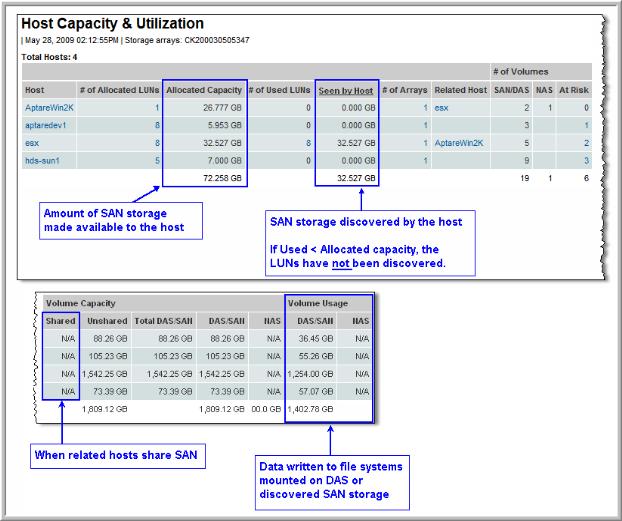

Host | The name of the host utilizing the storage. Click on a Host name link to view the Host Utilization Detail. |
# of Allocated LUNs | The number of LUNs that have been allocated to this host. Click on this number to launch the LUN Utilization Summary. |
Allocated Capacity | The total capacity of all Volumes both free and used that has been given to the host. When there is a significant discrepancy between the Allocated Capacity and the Seen by Host, it is an indication that there may be storage that can be reclaimable. |
# of Used LUNs | LUNs that are currently used by the host. Click on this number to launch the LUN Utilization Summary. |
Seen by Host | The sum of all SAN capacity actually deployed or accepted by the host. This is the storage that the host has been allocated and is using—but this use could be as simple as adding the storage to a volume group. It does not mean that the server has that storage mounted. Mounted storage is reflected in Total DAS/SAN. |
# of Arrays | The total arrays associated with this host. Click on the number to launch the Array Capacity and Utilization. |
Related Hosts | Hosts that are related to this host via clustering—they have multi-pathing to the same LUNs for fail over. |
# Volumes | |
SAN/DAS | The number of SAN/DAS volumes. |
NAS | The number of NAS volumes. |
At Risk | The number of host volumes that are at risk of reaching capacity, based on configured thresholds. Click on the number link to view the Host Utilization Detail. |
Volume Capacity | |
Shared | Represents the capacity that is shared by related hosts. |
Unshared | Capacity that is not shared by related hosts. |
Total DAS/SAN | Total of Shared and Unshared volume capacity. |
DAS/SAN | DAS/SAN storage capacity for this host. |
NAS | Total capacity of external, mounted filesystems (estimated). |
Volume Usage | |
DAS/SAN | This is the actual amount of SAN/DAS storage used by the host. |
NAS | The sum of currently allocated storage associated with external, mounted filesystems. The same NAS storage may be accounted for in multiple external filesystem mount points, resulting in double counting. |